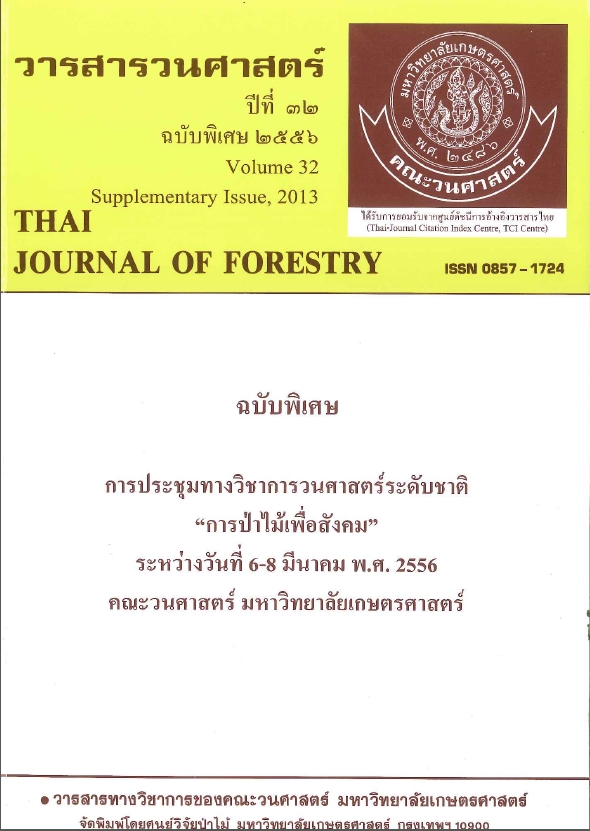การพัฒนาอุตสาหกรรมแผ่นชิ้นไม้อัดเรียงเสี้ยนจากไม้ผล
Main Article Content
บทคัดย่อ
การวิจัยครั้งนี้ได้นำไม้ผล 5 ชนิด คือ ไม้มะม่วง ไม้เงาะ ไม้ทุเรียน ไม้ลิ้นจี่ และไม้ลำไย มาทดลองทำแผ่นชิ้นไม้อัดเรียงเสี้ยนที่จัดเรียงแบบ 3 ชั้น โดยให้ไม้บางเรียงเสี้ยนไม้ตั้งฉากกันใช้กาวฟีนอล- รีซอรซินอลฟอร์มาลดีไฮด์ (PRF) และกาวโพลีเมอริค ไดฟีนิลมีเทน ไดไอโซไซยาเนต (pMDI) ในปริมาณ 3 ระดับ คือ ร้อยละ 5, 7 และ 9 ของน้ำหนักไม้บางแห้ง
ผลจากการนำไม้ผลมาผลิตแผ่นชิ้นไม้อัดเรียงเสี้ยนพบว่า ไม้มะม่วง ไม้ทุเรียน ไม้เงาะ ไม้ลิ้นจี่ และไม้ลำไย มีความเหมาะสมกับการผลิตเรียงลำดับจากมากไปน้อย และเมื่อเปรียบเทียบสมบัติกับเกณฑ์มาตรฐาน มอก. 876-2547 มาตรฐาน JIS A 5908 – 2003 และมาตรฐาน BS EN 300-1997 พบว่าเมื่อใช้กาว pMDI ที่ระดับปริมาณกาวร้อยละ 5 ของน้ำหนักไม้บางแห้งชนิดไม้ที่เหมาะสมในการผลิต คือ ไม้มะม่วง ไม้ทุเรียน และไม้ลิ้นจี่ การใช้ไม้เงาะต้องใช้กาวร้อยละ 7 ของน้ำหนักไม้บางแห้ง การใช้กาว PRF ที่ระดับปริมาณกาวร้อยละ 7 ของน้ำหนักไม้บางแห้งชนิดไม้ที่เหมาะสม คือ ไม้มะม่วง สำหรับไม้ทุเรียนใช้กาวปริมาณร้อยละ 9 ของน้ำหนักไม้บางแห้ง และจากผลการวิจัยยังพบว่า ไม้ลำไยไม่เหมาะสมในการนำมาทำแผ่นชิ้นไม้อัดเรียงเสี้ยน
แผ่นชิ้นไม้อัดเรียงเสี้ยนที่มีสมบัติผ่านตามเกณฑ์มาตรฐานผลิตภัณฑ์อุตสาหกรรม และมีต้นทุนในการผลิตต่ำที่สุด คือ การผลิตแผ่นชิ้นไม้อัดเรียงเสี้ยนที่ใช้กาว pMDI ร้อยละ 5 มีต้นทุนการผลิตต่อแผ่น เท่ากับ 53.41 บาทต่อแผ่น (35x35x1.0 เซนติเมตร) ส่วนการผลิตแผ่นชิ้นไม้อัดเรียงเสี้ยนที่ใช้กาว PRF ร้อยละ 7 มีต้นทุนการผลิตต่อแผ่นเท่ากับ 58.61 บาทต่อแผ่น (35x35x1.0 เซนติเมตร)
คำสำคัญ: กาวโพลีเมอริค ไดฟีนิลมีเทน ไดไอโซไซยาเนต กาวฟีนอล-รีซอรซินอลฟอร์มาลดีไฮด์ แผ่นชิ้นไม้อัดเรียงเสี้ยน
Downloads
Article Details

อนุญาตภายใต้เงื่อนไข Creative Commons Attribution-NonCommercial-NoDerivatives 4.0 International License.
ข้าพเจ้าและผู้เขียนร่วม (ถ้ามี) ขอรับรองว่า ต้นฉบับที่เสนอมานี้ยังไม่เคยได้รับการตีพิมพ์และไม่ได้อยู่ในระหว่างกระบวนการพิจารณาตีพิมพ์ลงในวารสารหรือสิ่งตีพิมพ์อื่นใด ข้าพเจ้าและผู้เขียนร่วม (ถ้ามี) ยอมรับหลักเกณฑ์และเงื่อนไขการพิจารณาต้นฉบับ ทั้งยินยอมให้กองบรรณาธิการมีสิทธิ์พิจารณาและตรวจแก้ต้นฉบับได้ตามที่เห็นสมควร พร้อมนี้ขอมอบลิขสิทธิ์ผลงานที่ได้รับการตีพิมพ์ให้แก่วารสารวนศาสตร์ คณะวนศาสตร์ มหาวิทยาลัยเกษตรศาสตร์ กรณีมีการฟ้องร้องเรื่องการละเมิดลิขสิทธิ์เกี่ยวกับภาพ กราฟ ข้อความส่วนใดส่วนหนึ่ง หรือ ข้อคิดเห็นที่ปรากฏในผลงาน ให้เป็นความรับผิดชอบของข้าพเจ้าและผู้เขียนร่วม (ถ้ามี) แต่เพียงฝ่ายเดียว และหากข้าพเจ้าและผู้เขียนร่วม (ถ้ามี) ประสงค์ถอนบทความในระหว่างกระบวนการพิจารณาของทางวารสาร ข้าพเจ้าและผู้เขียนร่วม (ถ้ามี) ยินดีรับผิดชอบค่าใช้จ่ายทั้งหมดที่เกิดขึ้นในกระบวนการพิจารณาบทความนั้น”


